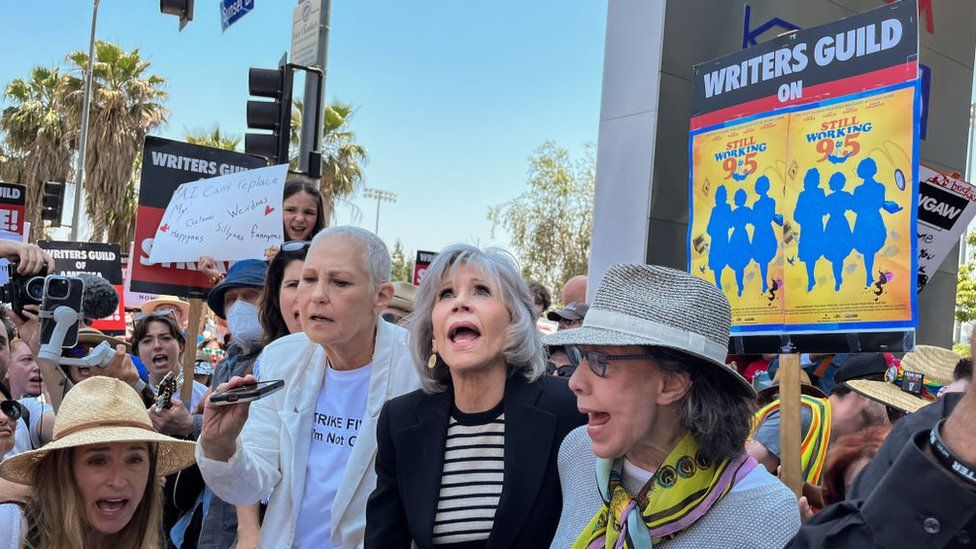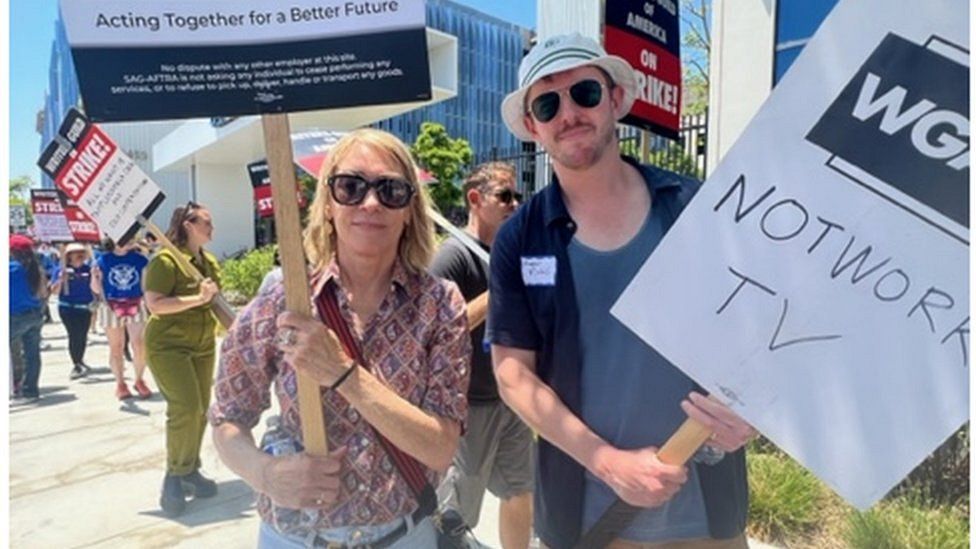Hollywood edges closer to actors strike as talks sour
By AFP
Published July 12, 2023
Actors have been supporting Hollywood writers on the picket line for weeks; now, they could formally join them on strike - Copyright AFP/File Robyn Beck
Andrew MARSZAL
Tens of thousands of Hollywood actors on Wednesday anxiously awaited their union’s decision on whether to strike, as last-ditch talks with the likes of Disney and Netflix appeared to sour just hours before the crunch deadline.
The Screen Actors Guild (SAG-AFTRA) has already agreed to one extension of talks with studios, but the two sides have still not been able to thrash out a deal over thorny issues of pay, the use of artificial intelligence, and more.
If midnight Wednesday (0700 GMT Thursday) passes without a deal or another prolongation, actors will hit the picket line, joining writers who have already been marching outside studios for more than two months.
“We are not confident that the employers have any intention of bargaining toward an agreement,” said the union, which represents some 160,000 actors and performers.
“Time is running out,” it warned.
A “double strike” of actors and writers, not seen in Hollywood since 1960, would bring nearly all US film and television productions to a halt.
It would also prevent A-listers from promoting some of the year’s biggest releases, right at the peak of the movie industry’s key summer blockbuster season, just as the industry attempts to rebound from the lean pandemic years.
Christopher Nolan’s “Oppenheimer” is due to have its US premiere in New York on Monday.
The massive annual Comic-Con pop culture gathering in San Diego next week could be stripped of its stars.
And a scheduled red-carpet launch this weekend at Disneyland for the new “Haunted Mansion” movie may be downgraded to a “private fan event.”
Such is the concern in Hollywood that powerful agency chiefs — who act as gatekeepers to Tinseltown’s starriest “talent” — have reached out to SAG leaders, offering to help smooth negotiations.
Hollywood studios have called in federal mediators to help resolve the deadlock.
SAG-AFTRA said Tuesday it had agreed to the studios’ “last-minute request” for mediation, while voicing skepticism about good-faith efforts on the other side.
The studios have “abused our trust and damaged the respect we have for them in this process,” it said.
“We will not be manipulated by this cynical ploy to engineer an extension when the companies have had more than enough time to make a fair deal.”
– ‘Swift resolution –
SAG members have pre-approved industrial action if a deal is not struck.
On Wednesday, Hollywood unions representing directors, behind-the-scenes film workers and writers issued a statement of “unwavering support and solidarity” with the actors.
“While the studios have collective worth of trillions of dollars, billions of viewers globally, and sky-high profits, this fight is not about actors against the studios,” it said.
Workers “across all crafts and departments” stand together “to prevent mega-corporations from eroding the conditions we fought decades to achieve,” it said.
While the writers’ strike has already dramatically reduced the number of movies and shows in production, an actors’ walkout would shutter almost everything.
Some reality TV, animation and talk shows could continue.
But popular series set to return to television this year face lengthy delays. And, if strikes continue, future blockbuster films would be postponed too.
Even the Emmy Awards, television’s version of the Oscars which is due to take place on September 18, is reportedly mulling a delay to November or even next year.
An actors strike would mean a boycott of the ceremony by stars.
“We hope the ongoing guild negotiations can come to an equitable and swift resolution,” said Television Academy chairman Frank Scherma, as the Emmy nominations were announced Wednesday.
– Pay and AI –
Should negotiations fail, it will be the first time that all Hollywood actors and writers have been on strike simultaneously since 1960, when actor (and future US president) Ronald Reagan led a showdown that eventually forced major concessions from the studios.
Like the writers, who have already spent 11 weeks on the picket lines, actors are demanding higher pay to counteract inflation, and guarantees for their future livelihoods.
In addition to salaries when they are actively working, actors earn payments called “residuals” every time a film or show they starred in is aired on network or cable — particularly helpful when performers are between projects.
But today, streamers like Netflix and Disney+ do not disclose viewing figures for their shows, and offer the same paltry flat rate for everything on their platforms, regardless of its popularity.
Muddying the waters further is the issue of artificial intelligence. Both actors and writers want guarantees to regulate its future use, but studios have so far refused to budge.
The mega-strike that could take down Hollywood
 GETTY IMAGES
GETTY IMAGESHollywood's writers have been on strike for two months and soon the actors may join them, swapping the red carpet for the picket lines.
The Screen Actors Guild-American Federation of Television and Radio Artists (SAG-AFTRA) contract expires at midnight local time on 12 July, following a deadline extension that delayed the possibility of a mega-strike by almost two weeks.
They would join the Writers Guild of America, which went on strike on 2 May after failing to reach a deal with the Alliance of Motion Picture and Television Producers (AMPTP), an umbrella group representing studios like Disney, Netflix, Amazon and Apple.
Both SAG-AFTRA and AMPTP have said they will not comment while contract negotiations are ongoing.
It would be the first time that unions representing both writers and actors would strike at the same time since 1960, when future US President Ronald Reagan was president of the actors' union.
A third union, the Directors Guild of America, has already negotiated a contract and will not join the strike.
Dozens of productions have already been halted since the writers went on strike, including Stranger Things, Billions and Marvel's Blade.
If there is an actors' strike, there could be even more delays, and some shows may be cancelled altogether.
For audiences, that likely means the next series of your favourite TV show will be delayed, and many shows may disappear forever.
While some international productions will continue, it will be limited, because SAG-AFTRA represents more than 160,000 performers around the world - like writer and actor Phoebe Waller-Bridge, who addressed the strike at the London premiere of the latest Indiana Jones movie.
"I really hope we can get this sorted. Writers are the most important people in this industry, I really believe that," she said.
Like the writers already on strike, actors say that streaming services haven't shared the wealth, even as they have led to an explosion of entertainment content. The never-ending quest for new subscribers is an unsustainable business model, they say, and studio executives are reaping huge salaries while many actors and writers can't make a decent living.
Actors and writers used to make money from re-runs on network TV. They would get a cheque in the post every time a movie or show they worked on was re-broadcast and that allowed actors to survive between projects in the business, which has always been a feast-or-famine job.
But streaming services upended Hollywood, and now actors and writers get little or nothing when someone watches their work on a streaming service, which also traditionally pays less than network TV.
The negotiations are being conducted in secret so it's not clear what might be the sticking points or if a deal is imminent. Members overwhelmingly voted in favour of a strike if a deal cannot be reached.
"If they could replace us, they would have done it many years ago," writer and actor Adam Conover said while picketing outside Netflix.
"Are they going to replace you with reality TV? Or with YouTube stars? Well, they can try," he said, adding that people around the world turn on the TV to watch shows like Stranger Things and sports.
 BBC/ REGAN MORRIS
BBC/ REGAN MORRISIn a surprise move, many of Hollywood's A-list actors signed a letter to their union supporting a strike if they cannot get a "transformative" new contract from studios.
The letter - which has been widely circulated in Los Angeles - was signed by the likes of Meryl Streep, Mark Ruffalo, Jennifer Lawrence and Quinta Brunson - has more than 1,000 signatures now, according to industry publication Deadline.
Both the writers and actors are striking for not only better pay, but for restrictions on using artificial intelligence (AI) in productions, which they say is an "existential" threat.
Actors say AI could create a doomsday scenario where deep fakes and dead actors could be the stars of tomorrow through computer-generated faces and voices.
For many in the business, it's a bleak thought - computer generated moviemaking without a camera crew, actor or writer involved.
Influential musician and artist Kim Gordon, the founder of Sonic Youth and a Screen Actors Guild member, said she'd never consider allowing an AI version of herself.
"It's important to be worried about it," Ms Gordon said while picketing outside Netflix. "But I feel like AI will never replace creativity."






